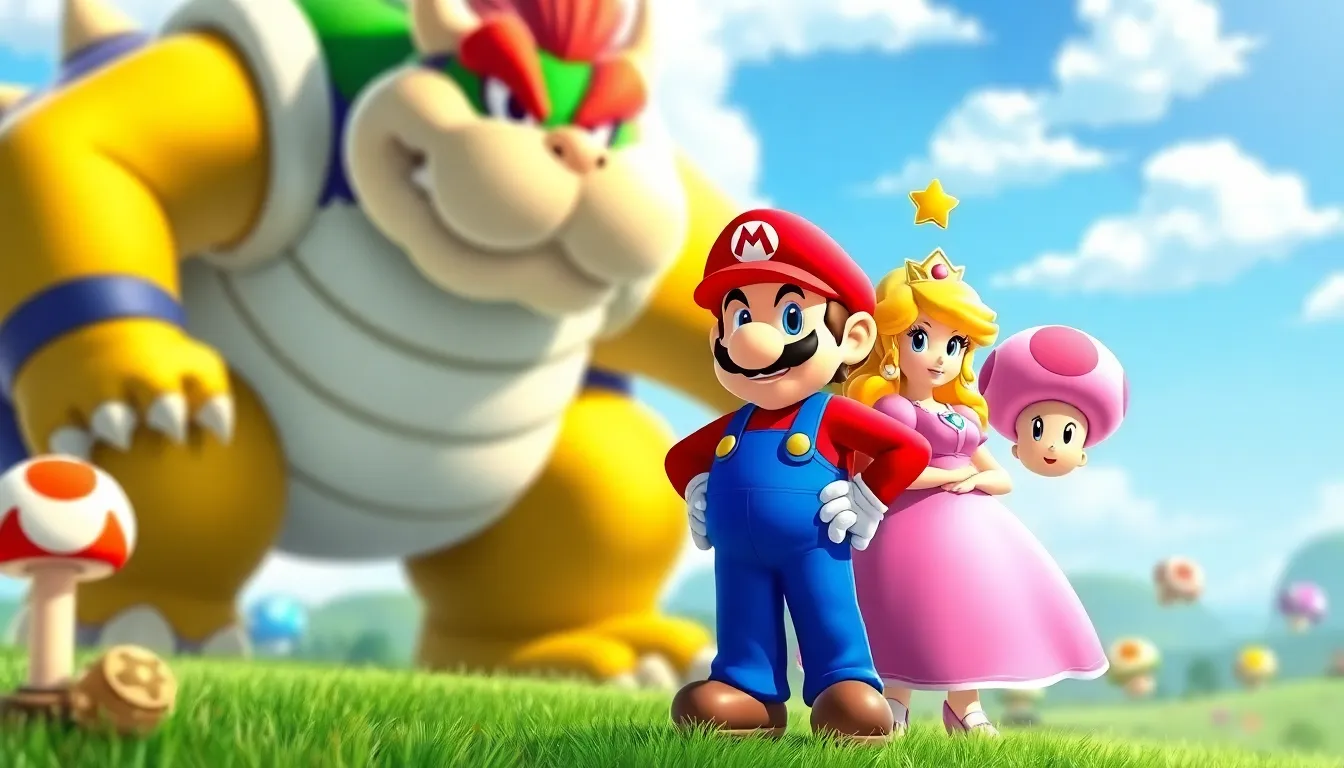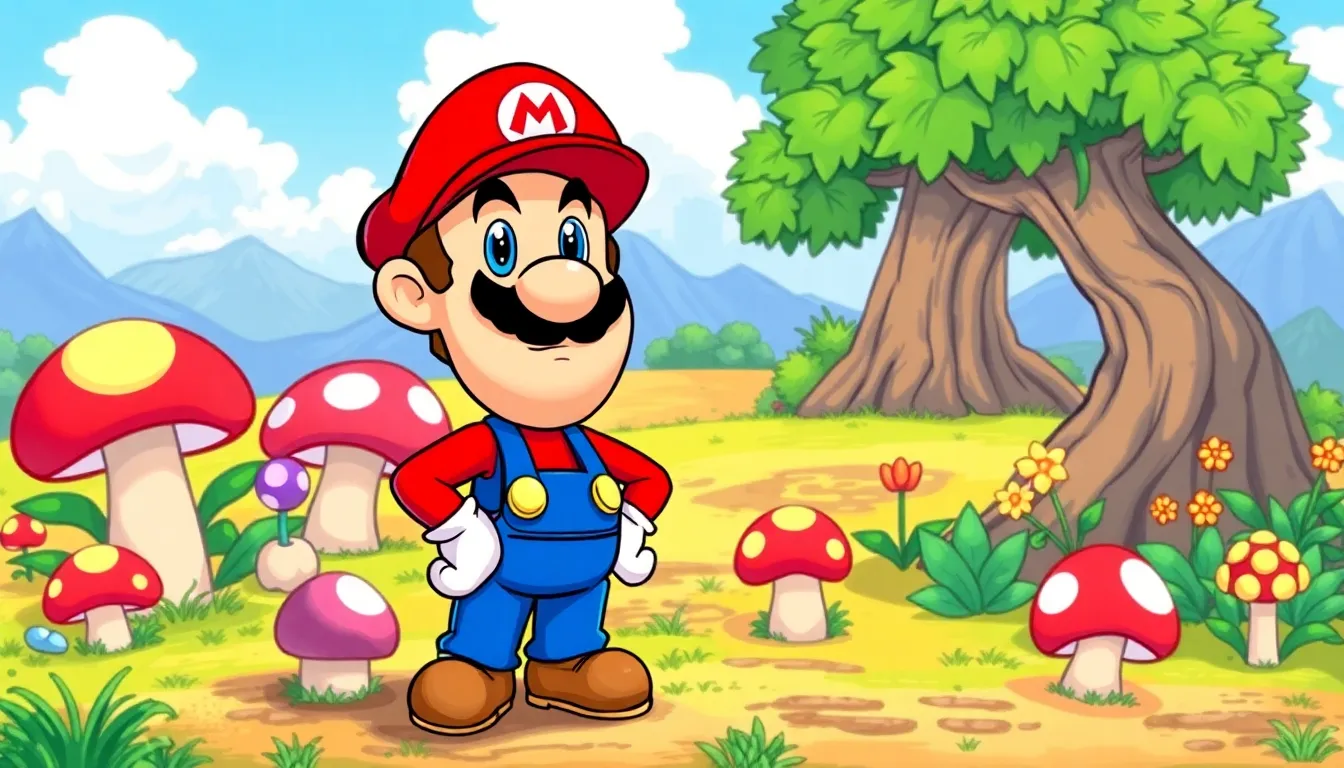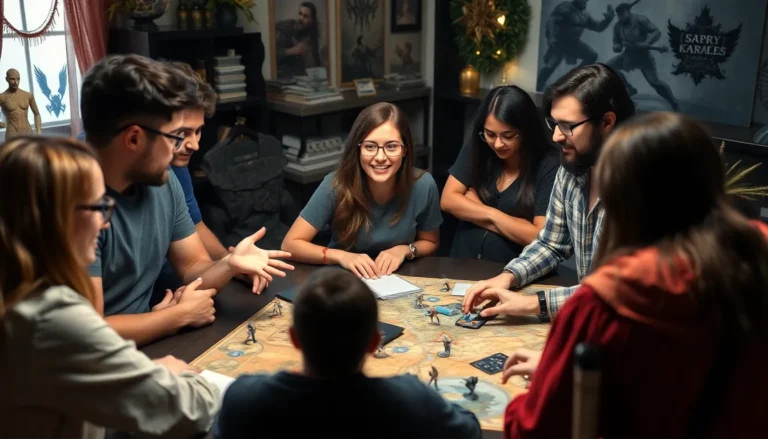In a world where princesses often find themselves in peril and mushrooms hold the key to power, Super Mario RPG: Legend of the Seven Stars stands out as a quirky gem. Released in 1996, this game isn’t just another platformer; it’s a delightful blend of role-playing mechanics and classic Mario charm that’ll have players laughing and strategizing in equal measure.
Table of Contents
ToggleOverview of Super Mario RPG Legend of the Seven Stars
“Super Mario RPG: Legend of the Seven Stars” debuted in 1996, creating a lasting impression in the gaming world. This game merges traditional role-playing game elements with the beloved characters from the Mario universe. Players embark on a quest to rescue Princess Toadstool, who faces capture by the antagonist, Smithy.
Gameplay involves exploring diverse environments, engaging in turn-based battles, and solving puzzles. In addition to classic Mario mechanics, the game introduces unique features like timed hits, enhancing combat strategy. Characters such as Bowser and Mallow join Mario on this adventure, each with distinct abilities contributing to gameplay dynamics.
The narrative focuses on the quest to collect seven star pieces, each guarded by formidable bosses, including the Bandits and the Ninja. By defeating these enemies, players unlock new areas and progress the storyline, ensuring a rich gameplay experience. Humor is woven throughout the journey, featuring light-hearted dialogue and whimsical scenarios that keep players engaged.
Visuals stand out due to charming 16-bit graphics, which effectively capture the vibrant essence of the Mario franchise. Sound design complements the experience with memorable tunes that enhance the adventure’s mood. This combination of elements creates an engaging atmosphere that remains enjoyable for newcomers and veterans alike.
With a blend of humor, strategy, and nostalgia, “Super Mario RPG: Legend of the Seven Stars” continues to be celebrated as a landmark title. Its influence persists in modern role-playing games, solidifying its legacy in the gaming industry.
Storyline and Characters

“Super Mario RPG: Legend of the Seven Stars” features a rich, engaging storyline filled with memorable characters. Players navigate a colorful world while collecting seven star pieces to thwart the plans of the antagonist, Smithy.
Main Protagonists
Mario serves as the main protagonist, embodying courage and determination. Accompanying him, Princess Toadstool showcases her resourcefulness and leadership. Throughout their journey, Bowser surprises players with his unexpected loyalty, revealing depth beyond his typical role as a villain. Mallow, a cloud-like character, adds humor and charm while expressing his quest for identity. Geno, a toy doll brought to life, possesses powerful abilities that enchant during battles. Together, these heroes create a dynamic team, each with unique skills that enhance gameplay.
Antagonists and Supporting Cast
Smithy, the primary antagonist, leads the gang of nefarious villains determined to conquer the Mushroom Kingdom. Each boss guards a star piece, presenting formidable challenges for players. Other antagonists include the cruel Valentina and the mischievous Croco, both contributing unique story arcs. Supporting characters enrich the plot, such as the quirky Toads who provide guidance and comic relief. The game also introduces various allies across the Mushroom Kingdom, enhancing the journey with their quirky personalities and abilities.
Gameplay Mechanics
“Super Mario RPG: Legend of the Seven Stars” features engaging gameplay mechanics that capture the essence of role-playing games while maintaining the humor of the Mario universe.
Combat System
The combat system encourages strategic thinking through turn-based battles. Players select actions from distinct menus, allowing for attacks, item usage, and special abilities. Timed hits serve as a core mechanic, granting players extra damage when executed precisely. Allies contribute unique skills during encounters, enhancing the depth of strategy. Boss battles introduce formidable challenges, requiring players to adapt to varied attack patterns and utilize their team’s strengths effectively.
Exploration and Quests
Exploration thrives within diverse environments, from lush forests to intricate dungeons. Players traverse the vibrant world, uncovering secrets, solving puzzles, and engaging with quirky characters. Side quests often reward exploration with hidden items or lore, enriching the overall experience. Collecting star pieces serves as a primary objective, guiding players toward formidable bosses while unlocking new areas. This design promotes a sense of discovery, making each interaction meaningful within the larger quest narrative.
Unique Features
“Super Mario RPG: Legend of the Seven Stars” features distinctive elements that enhance its charm. Players enjoy vibrant 16-bit graphics coupled with catchy soundtracks that elevate the gaming experience.
Graphics and Sound Design
The visuals captivate with colorful, whimsical landscapes, from lush forests to eerie castles. Each environment brims with personality, showcasing unique themes and artistic flair characteristic of the Mario series. Accompanying these stunning graphics are engaging sound effects and memorable music tracks that complement gameplay. Notable tunes enhance each character’s persona, making battles and explorations more thrilling. The combination of graphics and sound creates an immersive atmosphere that resonates with gamers.
Mini-Games and Secrets
Creative mini-games provide players with enjoyable diversions throughout the adventure. These interactive challenges reward skill and strategy, often resulting in rare items or essential upgrades. Secrets are also abundant; hidden paths and collectables entice exploration. Discovering these secrets fosters a sense of achievement while introducing surprises that enrich the narrative. The integration of mini-games and hidden treasures adds layers of fun, ensuring the game remains engaging long after the primary quest concludes.
Legacy and Impact
“Super Mario RPG: Legend of the Seven Stars” remains a cornerstone in video game history, blending genres and influencing future titles. Released in 1996, it introduced a new audience to role-playing games through the lens of the beloved Mario universe. Innovation defined its gameplay mechanics, from the engaging turn-based combat to the unique timed hit feature, setting a standard for RPGs that followed.
Critical acclaim accompanied its release, with reviewers praising its rich narrative and character development. Characters like Bowser and Geno resonated with players, showcasing depth uncommon in typical platformers. Nostalgia keeps it relevant, as gamers fondly remember its charm and humor, influencing countless RPGs over the years.
The game’s vibrant graphics set a benchmark for visual storytelling in 16-bit format. Musical compositions contributed to its enduring atmosphere, with catchy tracks enhancing the player’s experience. Memorable boss battles and engaging environments encouraged exploration, rewarding players with rich lore and unique items.
Community engagement remains strong through fan-created content, including remakes, mods, and art. Social media platforms celebrate the game, with dedicated fanbases discussing strategies and character lore. Its impact extends beyond gaming, inspiring fan art and merchandise that feature its iconic characters.
Legacy manifests in modern RPGs, establishing foundational principles that developers continue to build upon. Mechanics from “Super Mario RPG” can be seen in titles like “Undertale” and the “Mario & Luigi” series, demonstrating its lasting influence on the genre. Through gameplay innovations and storytelling techniques, “Super Mario RPG: Legend of the Seven Stars” solidifies its place in gaming history.
“Super Mario RPG: Legend of the Seven Stars” stands as a beloved classic that expertly blends humor and strategy within the Mario universe. Its innovative gameplay mechanics and memorable characters have left an indelible mark on the RPG genre. The game’s vibrant graphics and catchy soundtracks create an immersive experience that resonates with players even decades later.
As new generations discover this gem, its legacy continues to thrive. The influence of “Super Mario RPG” is evident in modern titles, showcasing its role in shaping the future of role-playing games. This timeless adventure not only entertains but also inspires creativity and community engagement among fans.




